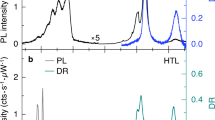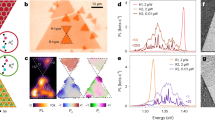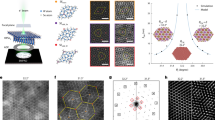Abstract
Van der Waals (vdW) heterostructures formed by two-dimensional atomic crystals provide a powerful approach towards designer condensed matter systems1,2,3,4,5,6,7,8,9,10,11,12,13,14,15. Incommensurate heterobilayers with small twisting and/or lattice mismatch lead to the interesting concept of moiré superlattices2,3,4,5,6,7, where the atomic registry is locally indistinguishable from commensurate bilayers but has local-to-local variation over long range. Here we show that such moiré superlattices can lead to periodic modulation of local topological order in vdW heterobilayers formed by two massive Dirac materials. By tuning the vdW heterojunction from normal to the inverted type-II regime via an interlayer bias, the commensurate heterobilayer can become a topological insulator (TI), depending on the interlayer hybridization controlled by the atomic registry between the vdW layers. This results in a mosaic pattern of TI regions and normal insulator (NI) regions in moiré superlattices, where topologically protected helical modes exist at the TI/NI phase boundaries. By using symmetry-based k ⋅p and tight-binding models, we predict that this topological phenomenon can be present in inverted transition metal dichalcogenides heterobilayers. Our work points to a new means of realizing programmable and electrically switchable topological superstructures from two-dimensional arrays of TI nano-dots to one-dimensional arrays of TI nano-stripes.
This is a preview of subscription content, access via your institution
Access options
Subscribe to this journal
Receive 12 print issues and online access
$259.00 per year
only $21.58 per issue
Buy this article
- Purchase on SpringerLink
- Instant access to full article PDF
Prices may be subject to local taxes which are calculated during checkout





Similar content being viewed by others
References
Geim, A. K. & Grigorieva, I. V. Van der Waals heterostructures. Nature 499, 419–425 (2013).
Ponomarenko, L. A. et al. Cloning of Dirac fermions in graphene superlattices. Nature 497, 594–597 (2013).
Dean, C. R. et al. Hofstadter’s butterfly and the fractal quantum Hall effect in moiré superlattices. Nature 497, 598–602 (2013).
Hunt, B. et al. Massive Dirac fermions and Hofstadter butterfly in a van der Waals heterostructure. Science 340, 1427–1430 (2013).
Gorbachev, R. V. et al. Detecting topological currents in graphene superlattices. Science 346, 448–451 (2014).
Song, J. C. W., Samutpraphoot, P. & Levitov, L. S. Topological Bloch bands in graphene superlattices. Proc. Natl Acad. Sci. USA 112, 10879–10883 (2015).
Jung, J., Raoux, A., Qiao, Z. & MacDonald, A. H. Ab initio theory of moiré superlattice bands in layered two-dimensional materials. Phys. Rev. B 89, 205414 (2014).
Yu, H., Wang, Y., Tong, Q., Xu, X. & Yao, W. Anomalous light cones and valley optical selection rules of interlayer excitons in twisted heterobilayers. Phys. Rev. Lett. 115, 187002 (2015).
Rivera, P. et al. Valley-polarized exciton dynamics in a 2D semiconductor heterostructure. Science 351, 688–691 (2016).
Fang, H. et al. Strong interlayer coupling in van der Waals heterostructures built from single-layer chalcogenides. Proc. Natl Acad. Sci. USA 111, 6198–6202 (2014).
Chiu, M.-H. et al. Spectroscopic signatures for interlayer coupling in MoS2–WSe2 van der Waals stacking. ACS Nano 8, 9649–9656 (2014).
Lee, C.-H. et al. Atomically thin p–n junctions with van der Waals heterointerfaces. Nat. Nanotech. 9, 676–681 (2014).
Furchi, M. M., Pospischil, A., Libisch, F., Burgdörfer, J. & Mueller, T. Photovoltaic effect in an electrically tunable van der Waals heterojunction. Nano Lett. 14, 4785–4791 (2014).
Cheng, R. et al. Electroluminescence and photocurrent generation from atomically sharp WSe2/MoS2 heterojunction p–n diodes. Nano Lett. 14, 5590–5597 (2014).
Hong, X. et al. Ultrafast charge transfer in atomically thin MoS2/WS2 heterostructures. Nat. Nanotech. 9, 682–686 (2014).
Qi, X.-L. & Zhang, S.-C. Topological insulators and superconductors. Rev. Mod. Phys. 83, 1057–1110 (2011).
Hasan, M. Z. & Kane, C. L. Colloquium: topological insulators. Rev. Mod. Phys. 82, 3045–3067 (2010).
Kane, C. L. & Mele, E. J. Quantum spin Hall effect in graphene. Phys. Rev. Lett. 95, 226801 (2005).
Bernevig, B. A., Hughes, T. L. & Zhang, S.-C. Quantum spin Hall effect and topological phase transition in HgTe quantum wells. Science 314, 1757–1761 (2006).
König, M. et al. Quantum spin Hall insulator state in HgTe quantum wells. Science 318, 766–770 (2007).
Ma, E. Y. et al. Unexpected edge conduction in mercury telluride quantum wells under broken time-reversal symmetry. Nat. Commun. 6, 7252 (2015).
Liu, C., Hughes, T. L., Qi, X.-L., Wang, K. & Zhang, S.-C. Quantum spin Hall effect in inverted type-II semiconductors. Phys. Rev. Lett. 100, 236601 (2008).
Knez, I., Du, R.-R. & Sullivan, G. Evidence for helical edge modes in inverted InAs/GaSb quantum wells. Phys. Rev. Lett. 107, 136603 (2011).
Karalic, M. et al. Experimental evidence for the topological insulator phase in InAs/GaSb coupled quantum wells. Preprint at http://arXiv.org/abs/1606.03627 (2016).
Nichele, F. et al. Edge transport in the trivial phase of InAs/GaSb. New J. Phys. 18, 083005 (2016).
Suzuki, K., Harada, Y., Onomitsu, K. & Muraki, K. Edge channel transport in the InAs/GaSb topological insulating phase. Phys. Rev. B 87, 235311 (2013).
Qian, X., Liu, J., Fu, L. & Li, J. Quantum spin Hall effect in two-dimensional transition metal dichalcogenides. Science 346, 1344–1347 (2014).
Abanin, D. A., Lee, P. A. & Levitov, L. S. Spin-filtered edge states and quantum Hall effect in graphene. Phys. Rev. Lett. 96, 176803 (2006).
Xiao, D., Liu, G.-B., Feng, W., Xu, X. & Yao, W. Coupled spin and valley physics in monolayers of MoS2 and other group-VI dichalcogenides. Phys. Rev. Lett. 108, 196802 (2012).
Mak, K. F., McGill, K. L., Park, J. & McEuen, P. L. The valley Hall effect in MoS2 transistors. Science 344, 1489–1492 (2014).
Sie, E. J. et al. Valley-selective optical Stark effect in monolayer WS2 . Nat. Mater. 14, 290–294 (2014).
Claassen, M., Jia, C., Moritz, B. & Devereaux, T. P. All-optical materials design of chiral edge modes in transition-metal dichalcogenides. Nat. Commun. 7, 13074 (2016).
Gong, C. et al. Band alignment of two-dimensional transition metal dichalcogenides: application in tunnel field effect transistors. Appl. Phys. Lett. 103, 053513 (2013).
Chiu, M.-H. et al. Determination of band alignment in the single-layer MoS2/WSe2 heterojunction. Nat. Commun. 6, 7666 (2015).
Liu, K. et al. Evolution of interlayer coupling in twisted molybdenum disulfide bilayers. Nat. Commun. 5, 4966 (2014).
Gong, Z. et al. Magnetoelectric effects and valley-controlled spin quantum gates in transition metal dichalcogenide bilayers. Nat. Commun. 4, 2053 (2013).
Liu, G.-B., Shan, W.-Y., Yao, Y., Yao, W. & Xiao, D. Three-band tight-binding model for monolayers of group-VIB transition metal dichalcogenides. Phys. Rev. B 88, 085433 (2013).
Lopes dos Santos, J. M. B., Peres, N. M. R. & Neto, A. H. C. Graphene bilayer with a twist: electronic structure. Phys. Rev. Lett. 99, 256802 (2007).
Mele, E. J. Band symmetries and singularities in twisted multilayer graphene. Phys. Rev. B 84, 235439 (2011).
Acknowledgements
The work is mainly supported by the Croucher Foundation (Croucher Innovation Award), the Research Grants Council and University Grants Committee of Hong Kong (HKU17312916, AoE/P-04/08), and the University of Hong Kong (ORA). Y.W. is partly supported by the NSFC with Grant No. 11604162 and Grant No. 61674083. X.X. is supported by the Department of Energy, Basic Energy Sciences, Materials Sciences and Engineering Division (DE-SC0008145 and SC0012509), and the Cottrell Scholar Award.
Author information
Authors and Affiliations
Contributions
W.Y. conceived and designed the research. Q.T. and H.Y. performed the calculations. Q.T., H.Y. and W.Y. analysed the results with input from Q.Z. and X.X. Y.W. provided support with first-principles calculations. W.Y., Q.T., H.Y. and X.X. prepared the manuscript.
Corresponding author
Ethics declarations
Competing interests
The authors declare no competing financial interests.
Supplementary information
Supplementary information
Supplementary information (PDF 954 kb)
Rights and permissions
About this article
Cite this article
Tong, Q., Yu, H., Zhu, Q. et al. Topological mosaics in moiré superlattices of van der Waals heterobilayers. Nature Phys 13, 356–362 (2017). https://doi.org/10.1038/nphys3968
Received:
Accepted:
Published:
Issue date:
DOI: https://doi.org/10.1038/nphys3968
This article is cited by
-
Förster valley-orbit coupling and topological lattice of hybrid moiré excitons
Communications Physics (2025)
-
Creating chirality in the nearly two dimensions
Nature Materials (2024)
-
Engineering interlayer hybridization in van der Waals bilayers
Nature Reviews Materials (2024)
-
Terahertz linear/non-linear anomalous Hall conductivity of moiré TMD hetero-nanoribbons as topological valleytronics materials
Scientific Reports (2024)
-
Heterostructures coupling ultrathin metal carbides and chalcogenides
Nature Materials (2024)



